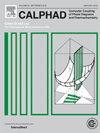Computational-thermodynamics-based martensite-start temperature models
IF 1.9
3区 材料科学
Q4 CHEMISTRY, PHYSICAL
Calphad-computer Coupling of Phase Diagrams and Thermochemistry
Pub Date : 2025-01-03
DOI:10.1016/j.calphad.2024.102776
引用次数: 0
Abstract
Thermodynamic models for the austenite-to-martensite phase transformation in steels were developed using the CALculation of PHase Diagrams (CALPHAD) modeling method. Previous modeling efforts from early empirical to more modern machine-learning (ML) models are reviewed and compared with the CALPHAD approach. An open-source, multicomponent thermodynamic database for steels was developed and used for the martensite model is made available for public use and collaboration. CALPHAD-based models for lath, plate, and epsilon martensite, including the effects of prior-austenite grain size, were developed using experimental data for binary and ternary iron alloys. A Gaussian process classification ML model was developed to predict the type of martensite that will form given a steel composition and martensite-start temperature () because this information is not always reported with the experimental measurements. The lath and plate models extend previous work using updated thermodynamic assessments and the open-source database while the epsilon model is made available for the first time. The accuracy of each model was also assessed and found to be reasonable compared to the expected experimental error associated with measurements.

基于计算热力学的马氏体起始温度模型
采用相图计算(CALPHAD)建模方法建立了钢中奥氏体向马氏体相变的热力学模型。回顾了以前的建模工作,从早期的经验到更现代的机器学习(ML)模型,并与CALPHAD方法进行了比较。开发了一个开放源代码的多组分钢热力学数据库,并将其用于马氏体模型,供公众使用和协作。利用二元和三元铁合金的实验数据,建立了基于calphad的板条、板条和epsilon马氏体模型,包括奥氏体晶粒尺寸的影响。开发了一个高斯过程分类ML模型来预测给定钢成分和马氏体起始温度(Ms)将形成的马氏体类型,因为该信息并不总是与实验测量一起报告。板条和板模型使用更新的热力学评估和开源数据库扩展了以前的工作,而epsilon模型是第一次提供。还评估了每个模型的准确性,并发现与Ms测量相关的预期实验误差相比是合理的。
本文章由计算机程序翻译,如有差异,请以英文原文为准。
求助全文
约1分钟内获得全文
求助全文
来源期刊
CiteScore
4.00
自引率
16.70%
发文量
94
审稿时长
2.5 months
期刊介绍:
The design of industrial processes requires reliable thermodynamic data. CALPHAD (Computer Coupling of Phase Diagrams and Thermochemistry) aims to promote computational thermodynamics through development of models to represent thermodynamic properties for various phases which permit prediction of properties of multicomponent systems from those of binary and ternary subsystems, critical assessment of data and their incorporation into self-consistent databases, development of software to optimize and derive thermodynamic parameters and the development and use of databanks for calculations to improve understanding of various industrial and technological processes. This work is disseminated through the CALPHAD journal and its annual conference.

 求助内容:
求助内容: 应助结果提醒方式:
应助结果提醒方式:


